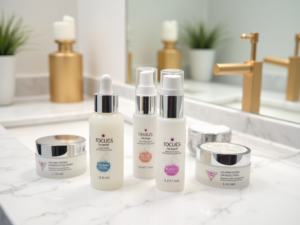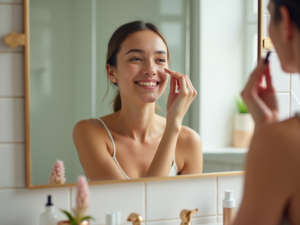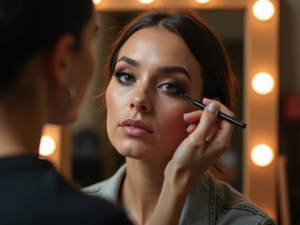Are you tired of dark circles, blemishes, or uneven skin tone? The ultimate concealer guide will help you understand every aspect of choosing and using the perfect concealer to achieve flawless skin. Ready to dive in? Let’s get started.
What is Concealer?

Concealer is a type of cosmetic product designed to mask imperfections on your skin. It’s usually thicker than foundation and provides fuller coverage. Concealers can cover a wide range of skin issues such as dark circles, blemishes, age spots, and redness. Many people use concealer in conjunction with foundation for a smooth and flawless finish.
Modern concealers come in various forms, including liquid, cream, stick, and powder, to cater to different skin types and concerns. It’s important to choose the right type of concealer for your specific needs and skin conditions. We’ll walk you through these different types in the following sections.
Types of Concealers
Understanding the different types of concealers available on the market is crucial in finding the perfect match for your skin. Below is a list of the primary types of concealers and their best uses:
-
Liquid Concealer:
Suitable for all skin types but especially beneficial for oily and combination skin. It provides buildable coverage ranging from light to medium and is excellent for covering large areas. -
Cream Concealer:
Ideal for normal to dry skin and offers medium to full coverage. This type is excellent for covering dark circles and blemishes. -
Stick Concealer:
Best for normal to dry skin and provides a full-coverage finish. Its thicker consistency makes it perfect for spot concealing and touch-ups. -
Powder Concealer:
Works well with oily and combination skin. It provides light coverage and is often used to set liquid or cream concealers.
How to Choose the Right Shade
Choosing the right shade of concealer is vital for achieving a natural look. Here are some tips to help you find your perfect match:
Determine Your Undertone:
Your skin’s undertone can be cool, warm, or neutral. If you have cool undertones, look for concealers with a pinkish hue. For warm undertones, opt for yellow or golden tones. Neutral undertones can leverage a blend of both.
Test Before You Commit:
Always test shades under natural light to get an accurate match. Apply a small amount on your jawline for the best color comparison.
Consider Your Skin Issues:
Use a concealer one to two shades lighter than your foundation for dark circles. For blemishes and redness, choose a shade closer to your foundation color.
Application Techniques
Applying concealer correctly can make all the difference. Here’s a step-by-step guide to ensure you get the best results:
Prep Your Skin:
Start with a clean and moisturized face. This will create a smooth canvas and help the concealer adhere better.
Use the Right Tools:
Depending on the form of concealer, use a brush, sponge, or your fingers for application. Brushes are great for precise application, while sponges provide a more blended finish.
Apply Strategically:
Dab the concealer on areas that need coverage and blend outwards. For under-eye areas, use a triangular application method to brighten and lift your look.
Set with Powder:
Set the concealer with a translucent setting powder to keep it in place and prevent creasing. Use a light hand to avoid caking.
Remember, less is more. Start with a small amount of product and build up if necessary.
Common Mistakes to Avoid
Even the best concealer can fall flat if not used correctly. Here are some common mistakes to avoid:
Using the Wrong Shade:
Using a concealer that is too light or too dark can make imperfections more noticeable. Always test for the correct shade.
Over-Applying Product:
Applying too much concealer can look heavy and cakey. Apply a thin layer and build if more coverage is needed.
Skipping Primer:
A primer can help the concealer adhere better and last longer. Skipping this step may result in uneven application and quick fading.
Not Setting with Powder:
Failing to set your concealer with a translucent powder can lead to creasing and fading over time. Always finish with a light dusting of setting powder.
Ignoring Different Needs:
Your under-eye area and blemishes may require different concealers and techniques. Don’t use the same product or method for different concerns.
Conclusion
The ultimate concealer guide equips you with the knowledge to select and apply the perfect concealer for your skin needs. Whether you’re covering dark circles, blemishes, or evening out your skin tone, using the right type, shade, and technique can make a world of difference. Avoid common mistakes, use our tips and tricks, and you’ll be on your way to achieving a flawless complexion.
FAQs
What is the best concealer for oily skin?
Liquid and powder concealers are usually best for oily skin. They provide good coverage without feeling too heavy or greasy.
Can I use concealer without foundation?
Yes, you can use concealer without foundation. It can be used for spot treatments to cover blemishes or under-eye circles. Just blend well for a natural look.
How do I prevent my concealer from creasing?
To prevent creasing, ensure you prep your skin well. Use a moisturizing eye cream, apply a primer, and set your concealer with a translucent powder.
Should I use a brush or sponge for applying concealer?
Both tools have their merits. Brushes are great for precise application, especially for blemishes. Sponges provide a more natural, blended finish, making them ideal for larger areas.
Can concealer be used as a highlighter?
Yes, a lighter shade of concealer can be used as a highlighter. Apply it to the high points of the face like the brow bone, cheekbones, and the bridge of the nose for a subtle lift and glow.



